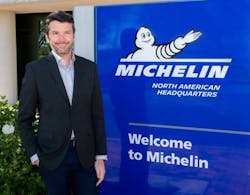Michelin's in Motion: Garcin Discusses Why Tire Dealers Will Remain 'At the Center' of Michelin's Strategy
In April, the Michelin Group revealed its Michelin in Motion strategy, which calls for 20% to 30% of the company’s total sales to come from “non-tire businesses” by the year 2030.
Michelin also announced that it will “expand, invest and innovate” in five areas, including services and solutions; flexible composites, such as conveyors, belts, coated fabrics and seals; medical devices; 3D printing; and “hydrogen mobility.”
Where do independent tire dealers fit into the equation? In this MTD interview, Alexis Garcin, chairman and president of Michelin North America Inc., explains the role dealers will play.
He also discusses the state of the North American tire market and why vehicle electrification is “one of the greatest opportunities we have together.”
MTD: The Michelin in Motion strategy calls for 20% to 30% of the company’s total sales to come from “non-tire businesses” within the next 10 years. It also outlines several areas where Michelin plans to invest and expand, including the services and solutions sector. Can you tell us more about the Michelin in Motion strategy, how it will come to life in North America and the role that independent tire dealers will play in delivering that vision?
Garcin: I joined the company almost 19 years ago and this is by far the most defining moment I’ve experienced in the group. We (recently) announced the acceleration of our strategy, which we call the Michelin in Motion strategy.
We’re in motion for our customers, we’re in motion for our people and we’re also in motion for the environment around us. And we intend to execute that strategy while focusing on three inseparable criteria: people, profit and planet.
There are three business segments (where) we want to accelerate our growth. The first one is our tire business. We believe the automotive market is on the cusp of its largest revolution ever and we see a lot of opportunities to bring new solutions.
The second business field is around tires. This is where we will accelerate our breakthroughs around services and solutions — leveraging our data capabilities that we have on truck tires and passenger car tires.
We want to have all of our passenger tires equipped with RFID by 2023 and then leveraging these capabilities with the great service network we have. This is where we are going to accelerate to deliver new service mobility offerings.
The third pocket of growth is what we call ‘beyond tires.’ Here we have different business segments. We have the medical sector. We have 3D printing. That is also a technology we have been developing in-house, so that we can, for example, use it to design new (tread) sculptures that are self-regenerating, so the more they get worn, the more open the sipes will be — so that grip can be maintained all (during) the tire life. That’s an exciting feature that we are able to provide in our tires and it’s born thanks to our homemade technology in 3D printing — and closing that growth ‘beyond tires’ with probably one of the most important ones, which is in high-tech materials.
And (you may say), ‘OK, Alexis, this is far from the tire business,’’ but it is not.Yes, it will open growth to new business territories, like aerospace, for example, but it’s also a way for us to have access to new materials that will be much more renewable and much more recyclable and that we will use to bring to the market by 2050 a 100%, fully renewable, recyclable tire.
At the end, everything is connected to mobility and to motion ... but we have to do that with the protection of the environment.
It’s not “either or” — it’s “and.” We have to develop our people, our profit and the planet at the same time. This is why it’s very exciting and at the core of our strategy.
MTD: As tire dealers continue to diversify the offerings they make available to their customers, can you elaborate on your plans for Michelin’s services and solutions business and how dealers will benefit from what will be developed?
Garcin: Our tire dealers are at the center of our strategy. We know today that the younger generation is already much more sensitive to the environmental question than maybe the older generation. By the fact that we are investing in (this) domain, we will be the ones that will support our dealers to have the right value proposition in the future because those environmental features in our tires will be even more important than (they are) today. The role of the tire dealer will be critical because we don’t invest in our own capabilities to deploy and execute those services. We do that with our service network partners and with retailers because we believe that there is no way we can do that today alone. Because of the nature of the thing now — that everything is getting digital and we have to move fast — we have to work in an ecosystem. That’s why I truly mean it when I say our dealers are at the center of our strategy.
MTD: Currently, electric vehicles (EVs) make up a small percentage of the North American vehicle population, but that is expected to change. What will the shift to EVs mean for tire dealers and how should they prepare for this new reality?
Garcin: This is one of the greatest opportunities we have together. You might think the evolution is slow, but what I can tell you from what I’ve seen all over the world is that this trend is going to accelerate dramatically, including in the U.S. There is a massive wave that is surging all over the world and (with) the latest announcements we’ve seen in the U.S., it’s going to happen here, too.
What does that mean for us? It’s a strong opportunity because those tires will require an enormous amount of technology. It will help our dealers to differentiate ... tires because to be able to maximize the range of the vehicle ... without compromising wet braking, safety and the longevity of the tire, you need to be an expert and have strong expertise in high-tech materials. And I think this will drive different business to our partners.
MTD: As EV technology evolves, tire technology will have to evolve along with it.
Garcin: Absolutely. Again, it comes back to the question of expertise that tire manufacturers will have to master very soon — if not already today — because you need different materials and different expertise to make sure you are able to combine all of the performance that is expected by car manufacturers and end users.
MTD: Minimizing performance trade-offs has always been an aspiration of tire manufacturers, but it seems even more critical now with the various dynamics that EVs present.
Garcin: Exactly. We’ve recently launched two tires — both in Europe — and both are about to come to North America. The first is on the passenger car (side). We call it the e.Primacy and this tire provides up to 7% more range for electric vehicles because of its optimization of rolling resistance.
And we just unveiled the Pilot Sport EV, which is a specific tire designed for electric sports cars. This tire is providing up to 37 miles of additional range because of its unique ability to minimize rolling resistance, while making no compromise on longevity, wet grip and safety.
MTD: As the light at the end of the COVID-19 tunnel appears on the horizon, what’s your take on the North American tire market for the rest of the year and into next year?
Garcin: Since March, we’re now comparing ourselves to 2019 and what I can tell (you) is that today we are seeing businesses that are recovering to pre-COVID levels.
MTD: What are the top challenges facing Michelin and other tiremakers that operate in the North American market over the next few years?
Garcin: Given the dynamics of our market, I see many, many opportunities. The fact we have a car parc that is going to be electrified, this is a really unique opportunity. And I really encourage our partners to invest in that segment so that we can really be ready to understand what are the specific features that those end users request and what are the right tires we need to put on those cars.
Our job as a mobility provider is to provide our dealers with solutions that will address the (needs) of the end user today and also tomorrow.
About the Author
Mike Manges
Editor
Mike Manges is Modern Tire Dealer’s editor. A 28-year tire industry veteran, he is a three-time International Automotive Media Association Award winner, holds a Gold Award from the Association of Automotive Publication Editors and was named a finalist for the prestigious Jesse H. Neal Award, the Pulitzer Prize of business-to-business media, in 2024. He also was named Endeavor Business Media's Editor of the Year in 2024. Mike has traveled the world in pursuit of stories that will help independent tire dealers move their businesses forward. Before rejoining MTD in 2019, he held corporate communications positions at two Fortune 500 companies and served as MTD’s senior editor from 2000 to 2010.

